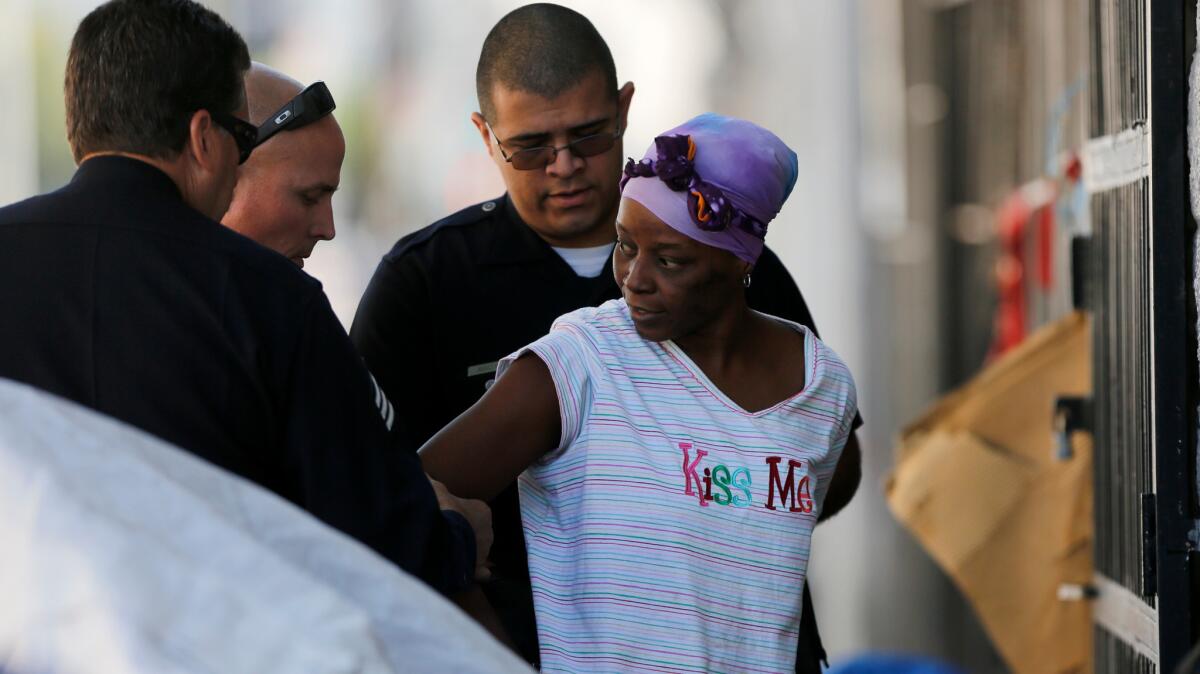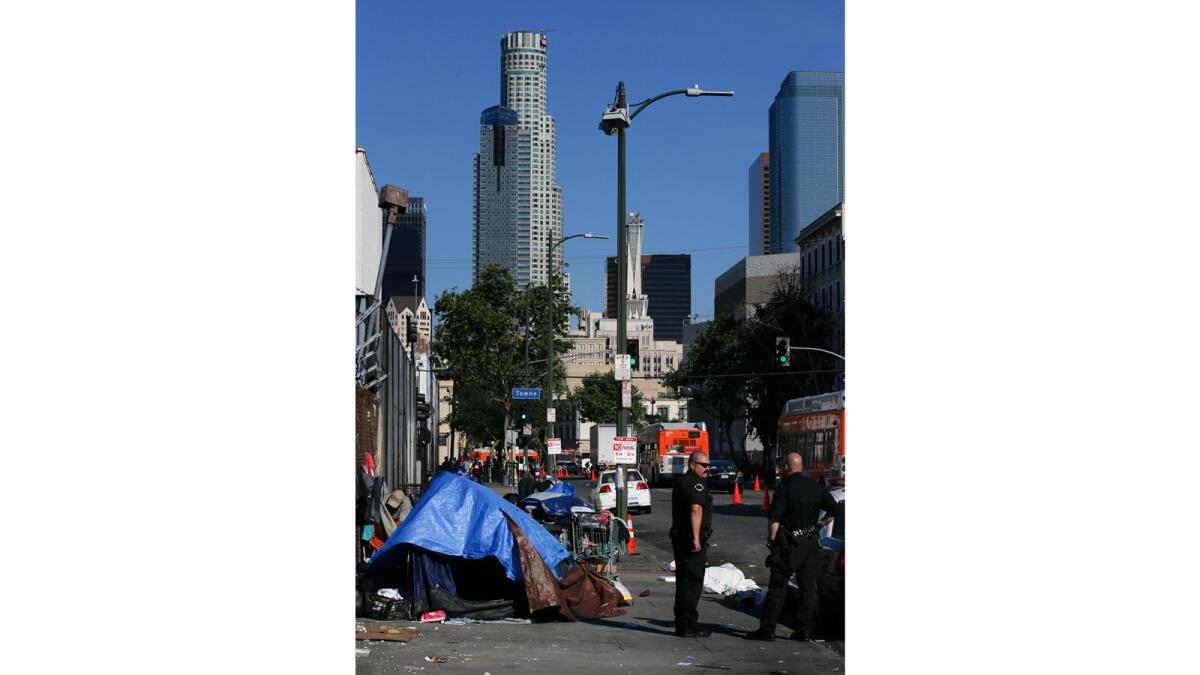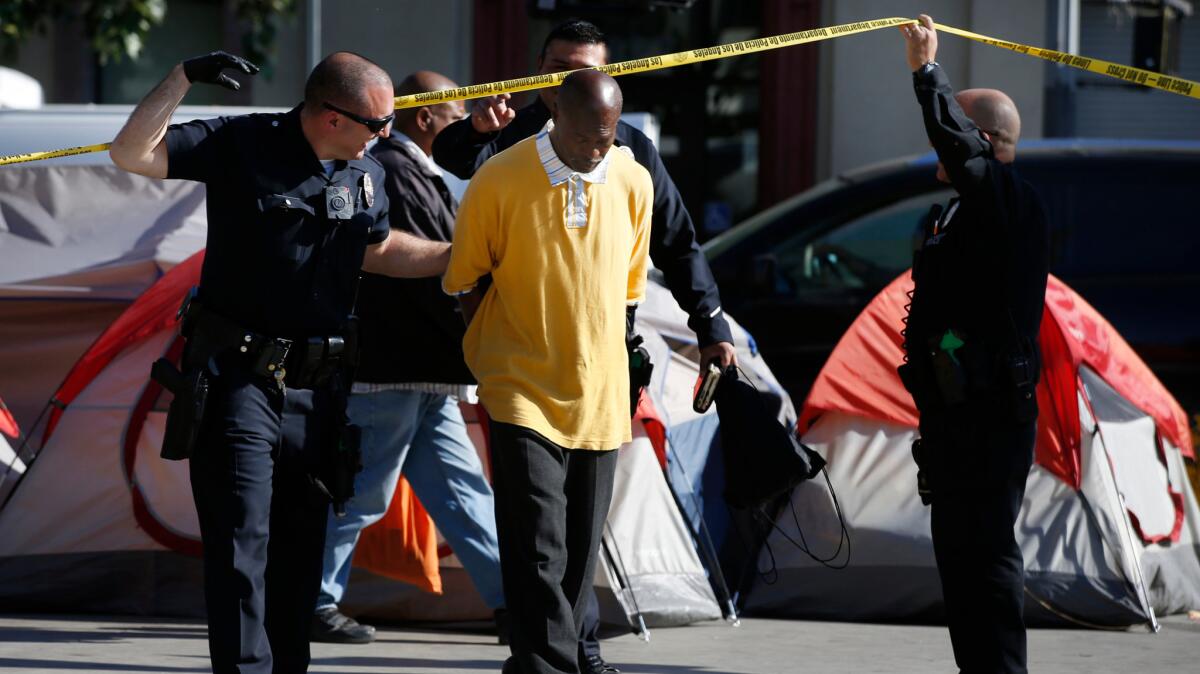What police are doing right (and wrong) with the homeless in downtown L.A.

- Share via
On March 1, 2015, Los Angeles police officers responded to a Sunday morning call on skid row about a dispute. A homeless man called Africa (Charly Leundeu Keunang) got into a scuffle with the officers, who shot and killed him. A bystander’s video of the incident went viral and brought new attention to long-standing concerns about heavy-handed police tactics in the 50-block region, often cited as the nation’s densest concentration of homeless people. Forrest Stuart’s “Down, Out and Under Arrest: Policing and Everyday Life in Skid Row,” based on the sociologist’s five years of ethnographic research, is an important contribution to the current hot debate on law, order and social justice. His findings are striking.
Rebutting anti-police rhetoric, he finds that unlike thuggish agents of “brute retribution,” patrol officers practice “therapeutic policing,” which is “a form of outreach social work that aims to transform and reintegrate residents as productive, self-governing citizens.” Police seek not to repress dysfunctional street dwellers vindictively but to push them into rehabilitation programs and otherwise help them reintegrate into society.
In the end therapeutic policing can cause more problems than it cures.
— Forrest Stuart in ‘Down, Out and Under Arrest’
Unfortunately, Stuart also finds that “In the end therapeutic policing can cause more problems than it cures,” because “For those on the receiving end, therapeutic policing feels less like helpful guidance and more like abuse.” Recent policing strategy on skid row rehabilitates few of the neighborhood’s disadvantaged residents but harasses and incarcerates many and disrupts their own self-help efforts. Stuart recommends greater toleration of skid row lifestyles and encourages community activist efforts, such as photographing and litigating police abuses. But he overlooks the possibility of reforming rather than abandoning therapeutic policing.
Stuart shows skid row police are “expressly oriented towards the task of recovery management, in which they attempt to reform even the most destitute and deviant.” Officers sincerely believe that hassling the homeless is good therapy because, as a patrolman says, “At least when I arrest a guy I can get him into the system,” that is, a rehabilitation program or some other avenue toward substance abuse treatment.
But to street dwellers, the whole recovery management process seems draconian. Private rescue missions require sobriety, work and commitment as prerequisites to aid and shelter. Police suppress informal, unconditional charity such as handouts. Officers prevent homeless people from lying down, sitting or just standing still in the belief that idleness encourages bad behavior. Quality-of-life violations are enforced more harshly against long-term residents to discourage attachment to the skid row lifestyle. Women, who are seen as more receptive to rehabilitation than men, especially receive unwanted police attention. Thus a coercive public order regime is justified by police as helping, not oppressing, the neighborhood’s disadvantaged residents.

But, the book shows, the help is not doing nearly as much good as is claimed. For example, the Streets or Services program offers some people arrested in skid row on quality-of-life charges a choice: Go to court and then probably to jail, or enter a 21-day rehabilitation program. Some officers even keep track of how many of their arrestees are diverted from jail into therapy and otherwise pride themselves as recovery managers. But only 10% of SOS enrollees ever complete rehabilitation. So, while the program fails at recovery, it justifies arresting skid row denizens for minor offenses that would have been overlooked in years past. Nor, we are told, does the practice of cracking down on small infractions — known as “broken windows” policing — deter major crimes.
For Stuart, therapeutic policing legitimates punitive treatment of the worst-off without making them or anyone else better off. Or rather, turning the police into social workers — and they make “abysmal social workers,” we are told — benefits not the street dwellers but the developers who can now make a profit in the domesticated neighborhood. “Down, Out, and Under Arrest” is thus a well-supported critique of therapeutic policing and, by extension, of similar paternalistic efforts to help the poor by hassling them into good behavior.
But some qualifications are necessary. First, the critique of broken-windows policing is a bit overdrawn. The original 1982 statement of the idea by J.Q. Wilson and George Kelling argued that police ought to enforce public order precisely because they could not drive down major crime rates. Maintaining order would at least make people feel safer, which would be significant in its own right. The idea was to insist that police could impact at least some social problems. Later formulations, as Stuart fairly notes, were more immodest. Further, is it so bad that therapeutic policing opened skid row to development? The wisdom of dedicating some of the most potentially valuable real estate on the planet to the warehousing of the extremely needy is not obvious.

More important, therapeutic policing may be capable of reform, as Stuart’s account of a group of skid row body builders suggests. These men work out with their scrounged collection of equipment — the “weight pile” — with the idea of keeping themselves healthy and out of trouble. The police resent the men’s preference for the weight pile over mission-sponsored treatment, and eventually break up the group, after which at least one member relapses into drug addiction. The author concludes that “therapeutic policing … actively delegitimizes and criminalizes indigenous, self-directed attempts at rehabilitation.” But this reader was left wondering why, instead of shutting down the weight pile, the police didn’t try to work with it. It turns out a local mission had a full gymnasium; why wasn’t that facility made more attractive to the weight-pile men? Between laissez faire tolerance of street lifestyles and coercive paternalism, can’t there be a reformed therapeutic policing that has a more realistic appreciation of street dwellers’ resistance to external control? Meeting the needs of the homeless up front and as they see them might well be more therapeutic than conditioning aid on good behavior — once needs are met, rehabilitation is more likely.
Stuart advises less concern for recovery and ending the harassment he believes it sanctions, which involves organizing the homeless to fight against police mistreatment. One community group does so by giving cameras to street dwellers who record bad police behavior for use in court. That evidence brought about a 2012 injunction issued by the 9th Circuit Court in Lavan v. City of Los Angeles that prohibits arbitrary confiscation of street dwellers’ belongings. So the harassment is ended, but people remain on the streets and in distress as rehabilitation is no longer a focus.

Los Angeles has something to learn from New York in working with street dwellers. The Big Apple once insisted that the indigent enroll in rehabilitation as a condition of receiving shelter or permanent housing. But many people on the streets recoiled at the constraints of therapy and simply stayed where they were. Eventually, New York adopted the “Housing First” policy of granting aid immediately and letting therapy kick in later, which encouraged both recovery and public order. To judge from Stuart’s fascinating account, Los Angeles should similarly reform, but not abandon, its efforts to rehabilitate both skid row and its residents.
Something like that may be happening. In September 2015, Los Angeles elected officials said they would devote up to $100 million to address the plight of the homeless, and voters may be asked to approve a $1-billion funding measure this fall.
Meanwhile, the Lavan injunction has been widely hailed as marking a new era in which the police “interact more sensitively with people who live on Skid Row.” The trick will be balancing the claims of both sensitivity and order.
Main is a professor at the School of Public and International Affairs at Baruch College of the City University of New York. His book, “Homelessness in New York City: Policymaking From Koch to de Blasio,” is published by NYU Press.
::
“Down, Out, and Under Arrest: Policing and Everyday Life in Skid Row”
By Forrest Stuart
University of Chicago Press: 352 pp., $27.50
More to Read
Sign up for our Book Club newsletter
Get the latest news, events and more from the Los Angeles Times Book Club, and help us get L.A. reading and talking.
You may occasionally receive promotional content from the Los Angeles Times.










